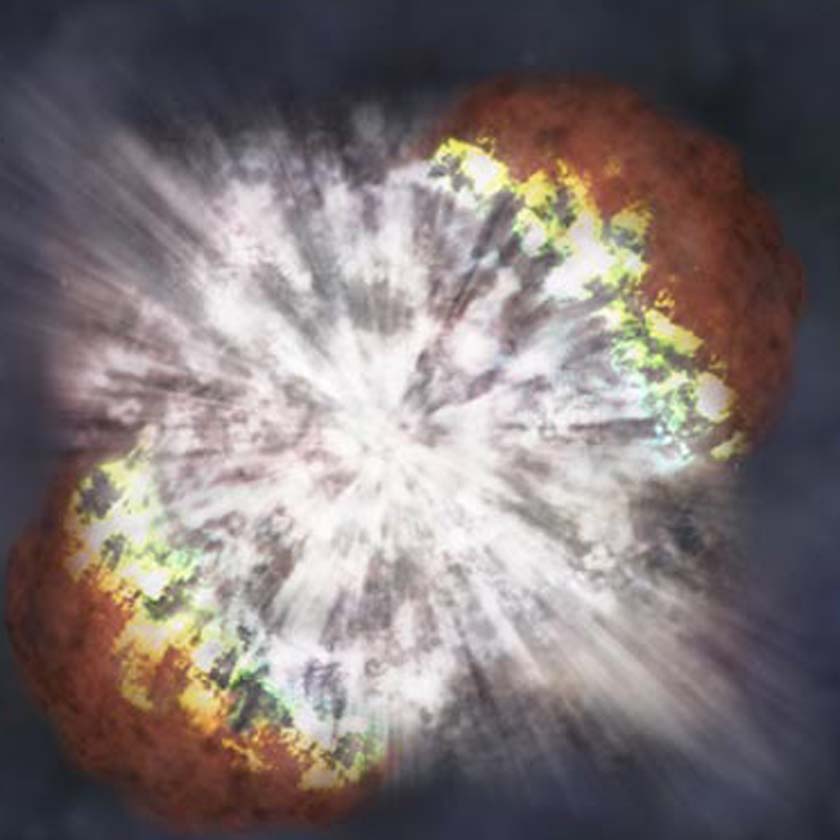KAMUELA, HI—Astronomers using the W. M. Keck Observatory and the European Southern Observatory’s Very Large Telescope have identified two distinct groups of stars within the Milky Way Galaxy’s globular cluster Terzan 5. The two stellar populations have different ages and iron abundances, which are rare features among globular clusters, suggesting that Terzan 5 could be a surviving remnant of pre-existing galaxy.
Orbiting the Milky Way’s Galactic Center, Terzan 5 is among the brightest star clusters and would easily be seen through binoculars were it not for the veil of dust between the Earth and this cluster. It was thought to be a “common” globular cluster, a compact population of stars bound by gravity with the same age and chemical composition. The new observations of this cluster, published in the Nov. 26 issue of Nature, demonstrate that Terzan 5 is not a genuine globular cluster but is the remnant of a proto-galaxy that merged with similar systems to form the Galactic bulge.
This discovery opens a new window on the formation mechanisms of galaxies and could be the first observational evidence to confirm that the bulge of a galaxy originates from the merging of pre-formed, internally evolved systems of stars, said the study’s lead author, Francesco Ferraro of the University of Bologna in Italy.
Ferraro and his colleagues studied Terzan 5, which is located in the central bulge of the Galaxy—a region that has been hard to study because of its high concentration of interstellar dust. Yet, the astronomers were able to identify two, distinct stellar populations—a bright one whose stars are centrally concentrated and a second one, whose stars are fainter—within Terzan 5.
Spectral data taken with the Keck II telescope and its NIRSPEC instrument also demonstrated that the brighter branch is roughly three times richer in metals, specifically, iron, which is formed in supernovae, said team member R. Michael Rich, of the University of California at Los Angeles.
“This new population is in fact among the most metal rich stars that we know of; it’s kind of like finding a buried treasure in this unusual star cluster,” said Dr. Livia Origlia of the Bologna Observatory, who discovered the iron-rich stars.
Astronomers have not previously observed such an anomaly in a Galactic Globular Cluster. The Milky Way has roughly 150 globular clusters, and, until now, omega Centauri was the only stellar system where distinct stellar populations with different iron content and age have been detected. This suggests it is the remnant of a disrupted dwarf galaxy that merged with the Milky Way late during its evolution. The striking peculiarity of Terzan 5 is that its oldest population has the same metal content as the most metal rich bulge stars. This strongly suggests that it is the relic of a building block of the Bulge: similar stellar systems would have merged together to finally form the Bulge during the early epoch of galaxy assembly.
Modeling the differing ages and abundances of metals among the star population in the Terzan 5 cluster suggests the entire cluster experienced a second burst of star formation six billion years after the initial burst, Ferraro said.
The models also suggest that ejecta of supernova explosions are the likely source of the heavier elements within the metal rich, bright star population of Terzan 5. Supernova ejecta, however, can only remain in systems much more massive than the current globular clusters. Therefore, we surmise that Terzan 5 is very likely to be yet another tattered relic of a pre-existing galaxy that was shredded and engulfed by the Milky Way, and the dust-obscured central region of the Galaxy may harbor many more similar objects, Ferraro added.
The European Southern Observatory operates the Very Large Telescope, made up of four separate 8.2 meter optical telescopes located in the Atacama desert in northern Chile.
The W. M. Keck Observatory operates two 10-meter optical/infrared telescopes on the summit of Mauna Kea on the island of Hawai’i. The telescopes feature a suite of advanced instrumentation including NIRSPEC, a near infrared echelle spectrograph commissioned on the Keck II telescope in 1999. NIRSPEC was constructed by the UCLA Infrared Laboratory, which celebrated its 20th anniversary on November 20, 2009. Keck Observatory is a scientific partnership of the California Institute of Technology, the University of California and NASA. For more information please call 808.881.3827 or visit http://www.keckobservatory.org.


